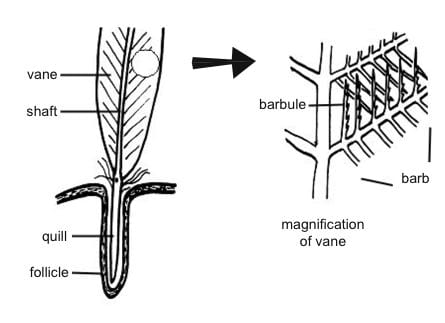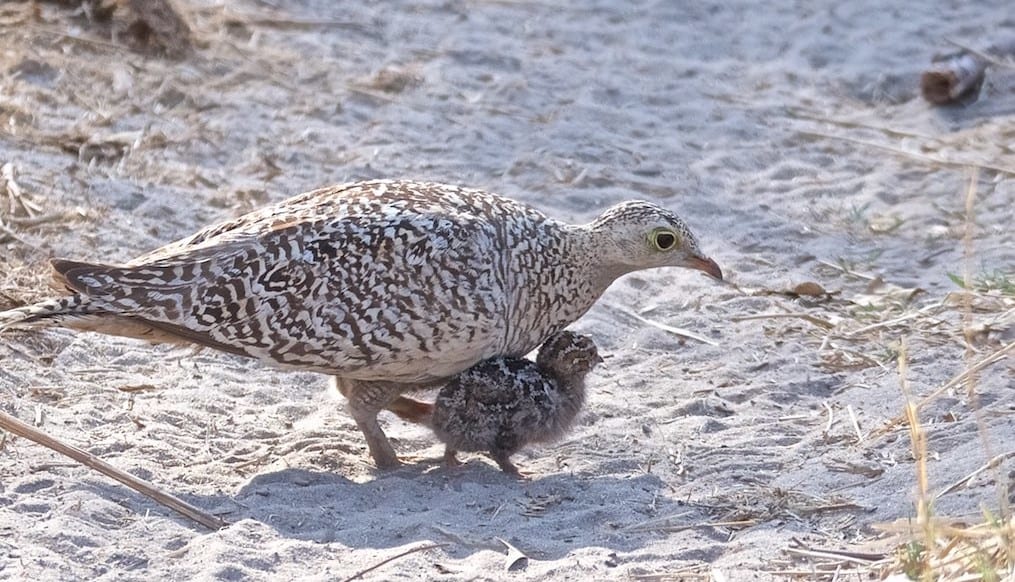Helically-structured barbules within the abdominal feathers of male sandgrouse reversibly absorb water.
Sandgrouse are a group of 16 species of ground-dwelling birds native to water-scarce, high-temperature regions of Africa and Asia. As exclusive seed eaters, sandgrouse obtain very little water through their diets, and therefore must drink liquid water regularly. Thus, many of the birds’ physical and behavioral traits are structured around their requirement for water in a demanding habitat.
Sandgrouse chicks rely on the delivery of water from their parents for 6-8 weeks, until they develop the flight capabilities necessary to travel to watering holes themselves. Unlike most birds, which use regurgitation to feed and water their young, 15 of the 16 sandgrouse species have a unique strategy to deliver water to these thirsty chicks. During a trip to a water source, a male sandgrouse performs a rocking motion in the water to thoroughly wet his specialized belly feathers. Upon returning to his nest, he stands upright and allows his chicks to suck water from his wet feathers. Sandgrouse have been observed transporting water in this manner upwards of 24 km (15 miles) from watering hole to nest. To avoid water evaporation over such long distances, sandgrouse typically fly during the coolest and most humid parts of the day (i.e. early morning or night).

This content marked as “Google Youtube” uses cookies that you chose to keep disabled. Click here to open your preferences and accept cookies..
The outer fifth of the male sandgrouse’s abdominal feathers resembles the waterproof feathers of other birds: loosely webbed hairlike structures (called “barbules”) extend from the branches (called “barbs”) that protrude from the main feather spine. However, the inner four-fifths of sandgrouse feathers instead have specialized flattened, ribbon-like barbules that coil about 3.5 times along each barb, forming an overlapping pattern. When dry, this structure appears as a springy, strong, and flat web. When wetted, the barbules uncoil rapidly, allowing minuscule filaments on the tips of the barbules to stand up. This structural change substantially increases the surface area of the feather, which then draws in water by . Male sandgrouse can carry an estimated 22 mL of water in their feathers—approximately 8 grams of water per gram of dry feather weight (this is at least twice as absorbent as a typical synthetic kitchen sponge!).
On a molecular scale, sandgrouse feathers are made primarily of the β-keratin. The arrangement of β-keratin molecules becomes less ordered (i.e. less crystalline) when wet, which may be essential to understanding the feathers’ absorbency. When a sandgrouse wets his belly feathers, water molecules bind with the charged (polar) parts of the barbules’ proteins, which then expand to accommodate the water. This process is what causes the β-keratin to lose some of its crystalline structure: molecules become more separated and randomly arranged. Notably, this mechanism is entirely reversible. Once dry, the feather barbules return to their coiled state, and the β-keratin recrystallizes.
It should be noted that most of the work on sandgrouse’s water-carrying strategy was completed between the 1960s-1980s. While these older scientific papers are still widely cited and the behavior is still commonly observed in sandgrouse, further research is needed to address unanswered questions about this water absorption mechanism.








